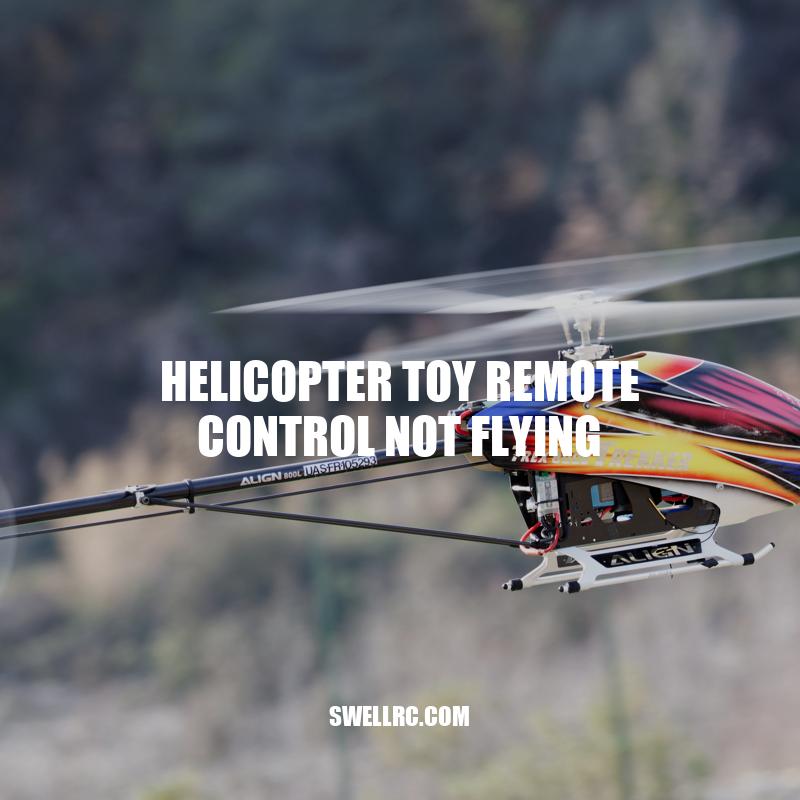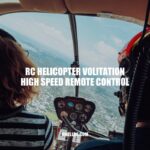Troubleshooting Remote Control Helicopter Issues
Remote control helicopters are popular toys that have captured the interest of many hobbyists and enthusiasts. They offer a fun way to experience the excitement of flying without leaving the ground. However, if your helicopter toy won’t fly when you operate the remote control, it can quickly turn into a frustrating experience. There are several reasons why a remote control helicopter might not take off and fly, and fortunately, there are also many troubleshooting tips that you can use to fix these issues. In this article, we will explore some of the most common reasons why a helicopter toy might not fly when using a remote control and suggest some ways to address these issues. By following these tips, you can enhance the performance of your remote control helicopter and enjoy the experience of flying it in no time.
Battery issues
One of the leading causes of remote control helicopter issues is often related to battery life and quality. Here are some troubleshooting tips to help you resolve these battery-related issues so your helicopter toy can start flying again:
- Try switching out the old batteries with new ones. This is a quick and easy way to fix the problem if the issue is related to low battery levels.
- Make sure that the batteries are inserted correctly. Sometimes, it’s easy to insert the batteries in the wrong direction or with the wrong polarity, so double-checking that can make a huge difference.
- Check for corrosion or rust around the battery terminals and clean them properly. If the terminals are dirty, they might prevent the batteries from making a proper connection, leading to poor performance or failure to fly.
- Invest in high-quality rechargeable batteries that have a high rating for performance, as they can last longer and offer better power output than low-quality ones.
By following these tips, it’s possible to resolve battery-related issues and ensure that the helicopter toy can fly optimally. Additionally, consulting manufacturers’ instructions can be a great guide to choosing the best batteries for the particular helicopter model. Some online markets offer high-quality batteries for remote control toys, and even manufacturer-owned websites offer useful tips for troubleshooting.
Why won’t my RC helicopter lift off?
If you have a fixed pitch RC helicopter and it won’t lift off, it’s likely due to not having enough rotor speed. Some factors that could be causing this include a bad or weak battery, a worn-out faulty motor, or issues with the bearings or magnets. Be sure to check these components first to troubleshoot the problem. If you need further assistance, consider looking at RC hobbyist websites or reaching out to the manufacturer for guidance.
If the helicopter toy remote control is not flying, there could be a few reasons why. The first thing to check is the batteries. Ensure that the batteries in both the remote control and the helicopter toy are fresh and fully charged. Replace the batteries if necessary.
If the helicopter toy’s batteries are not the problem, the next thing to check is the remote control calibration. Here’s how to fix calibration errors:
- First, turn off the remote control and unplug the battery from the helicopter toy.
- Ensure that the throttle stick is at the bottom position while doing the calibration.
- Turn on the remote control, while holding down the “calibrate” button until the lights start flashing.
- Let go of the “calibrate” button and place the throttle stick back to its original neutral position.
- The helicopter toy should start to quietly beep to indicate calibration is in process.
- After the beeping stops, turn off the remote control and re-plug the battery back into the helicopter toy.
- Now turn on the remote control again and the calibration process should be complete.
One of the most common reasons for calibration errors is accidentally moving the controls while the helicopter toy is being powered on. It is crucial to keep the controller still during the initialization or calibration process. The table below shows some of the common solutions to calibration problems.
| Calibration Symptoms | Possible Solutions |
|---|---|
| The helicopter rotates even when the controller is centered | Make sure both joysticks are centered during the calibration process |
| The helicopter drifts to one side during hovering | Adjust the trim located around the joysticks to fix the drifting issue |
| The helicopter does not respond to the controls | Recalibrate the remote control and the helicopter toy |
By following these tips, you should be able to resolve calibration issues and get the remote control helicopter toy back in the air. Additionally, consulting the manufacturer’s website or customer support can also be a great guide to fix calibration errors and other issues.
What are remote control helicopters called?
Remote control helicopters are commonly referred to as multirotor model helicopters. These helicopters are popular in both the RC hobby and unmanned aerial vehicle research. They use an electronic control system and sensors to stabilize the aircraft. For more information, you can check out websites like hobbyking.com or horizonhobby.com to see a variety of remote control helicopters.
If the battery and remote control calibration are not the problem, then the issue may be mechanical. Here are some ways to diagnose and fix mechanical issues with the helicopter toy remote control:
- Check for any visible damage to the helicopter‘s blades or other components.
- Make sure the blades are securely attached and balanced.
- If one of the blades seems to be wobbling or loose, it may need to be tightened or replaced.
- Check for any debris or foreign objects in the helicopter‘s moving parts.
- Ensure that the helicopter‘s rotor shaft is straight and not bent.
- If the helicopter toy remote control is still not flying, it may be time to replace a part or consult the manufacturer’s website to find replacement parts.
It’s important to note that mechanical issues are more difficult to fix, and some may require consulting an expert or a qualified repair technician. Additionally, regular maintenance and cleaning of the helicopter toy remote control can prevent mechanical problems from occurring in the first place. The table below lists some common solutions for mechanical problems with remote control helicopters.
| Mechanical Problems | Possible Solutions |
|---|---|
| The blades do not spin or spin too slowly | Check the battery and replace if necessary, replace or tighten the blades |
| The helicopter toy remote control is unstable and wobbles during flight | Replace the blades, ensure the rotor shaft is straight, and make sure the helicopter is properly balanced |
| The helicopter toy remote control crashes or does not respond to controls | Check for visible damage or foreign objects in the moving parts, replace damaged or broken components, or get expert repair services for more severe issues |
Following these steps should help you diagnose and rectify mechanical issues with the helicopter toy remote control, and get it flying again. If these procedures do not work, you may consider reaching out to customer support or finding a qualified technician for repair services. Don’t forget to check the remote control helicopter models available in Amazon if you need a replacement part or a new toy.
Why is my remote control helicopter not taking off?
If you have a fixed pitch RC helicopter that won’t take off, the most likely cause is that you don’t have enough rotor speed. Common issues to check for include a weak or dead battery, which is usually the most common cause. You should also inspect the motor for signs of wear and tear, such as shot bearings or magnets. If you have accomplished these basic checks, and your helicopter still won’t fly, you may need to consult the product manual or a reputable website for further troubleshooting tips.
Environmental factors
Sometimes, environmental factors can make it difficult for the helicopter toy remote control to fly smoothly. Here are some common environmental factors that can affect remote control toy flight, and ways to mitigate their impact:
- Wind: Strong winds can make it challenging for a helicopter toy to stay up in the air. Avoid flying the toy on windy days, or find an indoor location to fly the toy instead.
- Obstacles: Large objects such as furniture or decorative pieces can make it difficult for the toy to fly around the room. Choose a location that is open and free of obstacles.
- Indoor lighting: Some indoor lighting like fluorescent lights can interfere with the remote control’s signal, making it harder to control the helicopter toy. Use natural lighting if possible or avoid areas with strong indoor lighting.
When flying the helicopter toy, it’s also essential to choose a location where the toy can move safely without crashing into obstacles or people. Additionally, it’s a good idea to practice flying in an open space or with a training tool like a beginner remote control helicopter. Some manufacturers offer beginner-friendly models with intuitive controls and safety features which are perfect for mastering the basic skills of remote control toy flying.
In conclusion, flying a helicopter toy requires proper mechanical maintenance, well-functioning batteries, and calibration of the remote control. External factors like wind and obstacles may also interfere with smooth flight patterns. By following these troubleshooting tips and ensuring to choose the right location and time to fly, you’ll be able to enjoy your helicopter toy and have fun flying it for hours.
Conclusion
In summary, remote control helicopters can make exciting and engaging toys for people of all ages. However, there may be times where the toy just won’t fly as expected. The troubleshooting tips in this article can help to identify and fix some of the most common issues associated with remote control helicopter toy flying.
To ensure better flight experiences, you should always check the helicopter’s battery life and quality, recalibrate the remote control regularly, and fix mechanical issues promptly. Furthermore, you should choose the right location to fly your toy, avoiding windy areas or indoor locations with obstacles that may affect its flight.
If all else fails, don’t hesitate to reach out to customer support or a qualified technician for assistance. With the right care, maintenance, and troubleshooting, your helicopter toy can provide hours of fun and entertainment.
In conclusion, follow these troubleshooting tips and enjoy the delights of flying your remote control helicopter toy!



